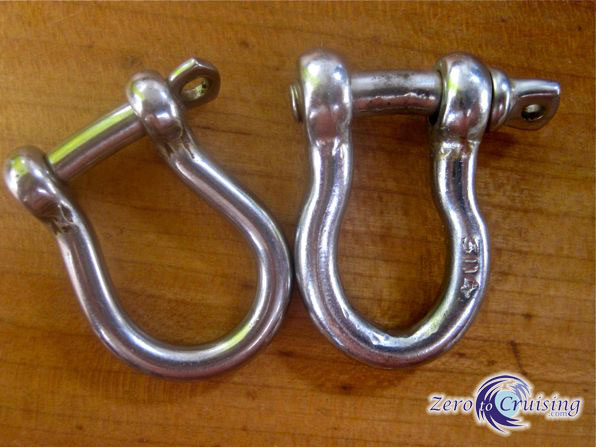Jury-rig
Something I have been curious about, how to jury-rig a mast, is explained well in this excellent video. In my opinion it’s definitely worth the 15 minute view. It includes some cool tips, especially the shackle detail.
Speaking of shackles, I noticed the other day while trying to reproduce the trick I just mentioned that the two shackles we used to secure our Genoa turning blocks are both bent. I never noticed it when I last removed them because they were lashed on to the cleats and the blocks that they held had integral snap shackles, meaning that I didn’t need to unscrew the pins to unfasten them. You think maybe there was a “bit” of force on them? I guess we need to use larger shackles next time we rig that sail!



Hi Mike and Rebecca,
Love the blog……
Perhaps if you run out of topics, you might say a few words on this.
Obviously your many many extended shore excursions have worked out very well.
Have you had any concerns about
1) the boat dragging while you are away? For example this weather shift, what would you have done if this happened while you were an hour away a couple nights ago?
2) security on the boat while you are away?
3) securing the dinghy ashore? (or do you always get a ride in when you are gone for an extended period.
Thanks!
Hi Jonathan
Thanks for the comment. It might be a while before I run out of things to post about but I appreciate the suggestions. 🙂
The simple answer to all of those is that yes, we are aware of the potential dangers associated with those things and we do our best to prepare for them by:
1. Securing our boat as best we can in safe harbors
2. Locking the companionway door and all hatches when we are away
3. Locking the dinghy in what we believe will be a safe location
As our past posts will show, MOST times these steps have kept us safe. There is no way to eliminate danger though other than staying on the boat, tied to a dock in a hurricane hole. We prepare as best we can and then let the chips fall where they will.
Beware the integral snap shackles on your blocks. They tend to be weaker than good stainless steel ones and much less reliable. Those two had certainly had some force!
Mike
They came with the boat. I am not a fan of snap shackles, period!
Thanks for posting that great video. Heaven forbid we ever have to put those skills to work…but it’s great to have an idea of how to set up a jury-rigged mast just in case….
Thanks,
Katie and Mark
Nice video – very similar (ha ha) to what we used to do on farm ponds growing up.
Boards, nails, hemp rope and sheets work, but that was much cooler.
Farm ponds?
It’s a Southern thing. Everybody has one, at least every farm has one.
Roger.
Just re-read your last post about your night time sail about. Would it not have been easier to have simply hove-to once you were far enough out? It is comfortable for both the crew and the boat, very safe and simple.
Admittedly some recommended ways of heaving-to on cats cause them to sit sideways to the swell. That is safe but not nice. I prefer to try and sit at 45deg or so, either moving slightly forwards or backwards depending on circumstances. Generally working slowly backwards is more comfortable.
Mike
With an onshore breeze, which is what we had for a considerable part of the evening, we would have eventually drifted down on the land. I wasn’t planning on sailing 20 miles offshore to play with that.
Good thinking! Mind you, you only drift at half a knot or something, still I see your point.
Mike
The shackles are probably large enough; the problem is that the same person who fitted the snap shackles (probably not the factory) also used bow shackles instead of D-shackles. Unless you are rigging an anchor, don’t use them. They are weaker and, in some applications, they can flop around and get loaded sideways, where they are VERY weak. The WORKING load on the turning blocks is probably ~ 1700 pounds (line force times ~ 1.8) at times, but it depends on how tight you grind them.
My spinnaker and genoa were added post-factory and were miss-rigged too. Additionally, I snapped a self-tacking jib shackle (bow shackle) on the Delaware Bay on a windy day; getting it under control was a drag.
I wasn’t aware that there was a significant strength difference between bow shackles and D-shackles. I’ll keep that in mind for the future!